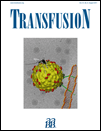Antibodies to oxaliplatin, a chemotherapeutic, are found in plasma of healthy blood donors
Abstract
BACKGROUND: Oxaliplatin is one of the platinum chemotherapeutics that includes cisplatin and carboplatin. Antibodies to all three drugs have caused immune hemolytic anemia (IHA). In an investigation of oxaliplatin-induced IHA, the negative plasma control agglutinated oxaliplatin-coated red blood cells (RBCs). Previous preparations of this control had not agglutinated oxaliplatin- or cisplatin-coated RBCs.
STUDY DESIGN AND METHODS: Drug-coated RBCs, prepared by incubating 1/10th volume of RBCs with 1 mg/mL drug in phosphate-buffered saline for 1 hour at 37°C, were incubated with plasma from random blood donors and patients. Plasma was treated with dithiothreitol to determine the immunoglobulin class. Hapten inhibition was performed by incubating plasma with solutions of oxaliplatin or cisplatin.
RESULTS: Nineteen of 121 (16%) donors' plasma samples agglutinated oxaliplatin-coated RBCs; 7 of 102 (7%) donors' plasma samples agglutinated cisplatin-coated RBCs. Two of 50 (4%) patients' samples agglutinated oxaliplatin-coated RBCs. The agglutinin was immunoglobulin M and inhibited by oxaliplatin and cisplatin.
CONCLUSION: An agglutinin reactive with oxaliplatin-coated RBCs was found in 16% of donors' and 4% of patients' samples. Inhibition by oxaliplatin and cisplatin indicates the antibody may be directed to platinum. The presence of this antibody in healthy individuals may be related to the increasing environmental presence of platinum in air and soil as a byproduct of automobile catalytic converters and pharmaceuticals in our water and food chain. This antibody in individuals without IHA suggests that testing untreated and enzyme-treated RBCs in the presence of a solution of drug may be the best method to investigate IHA caused by drugs in the platinum family.




